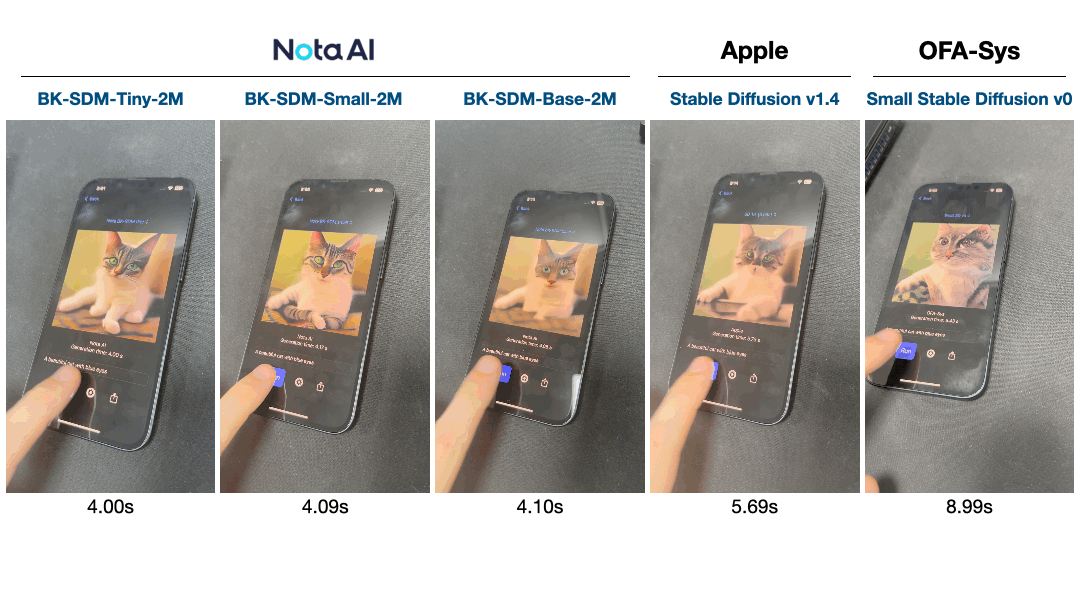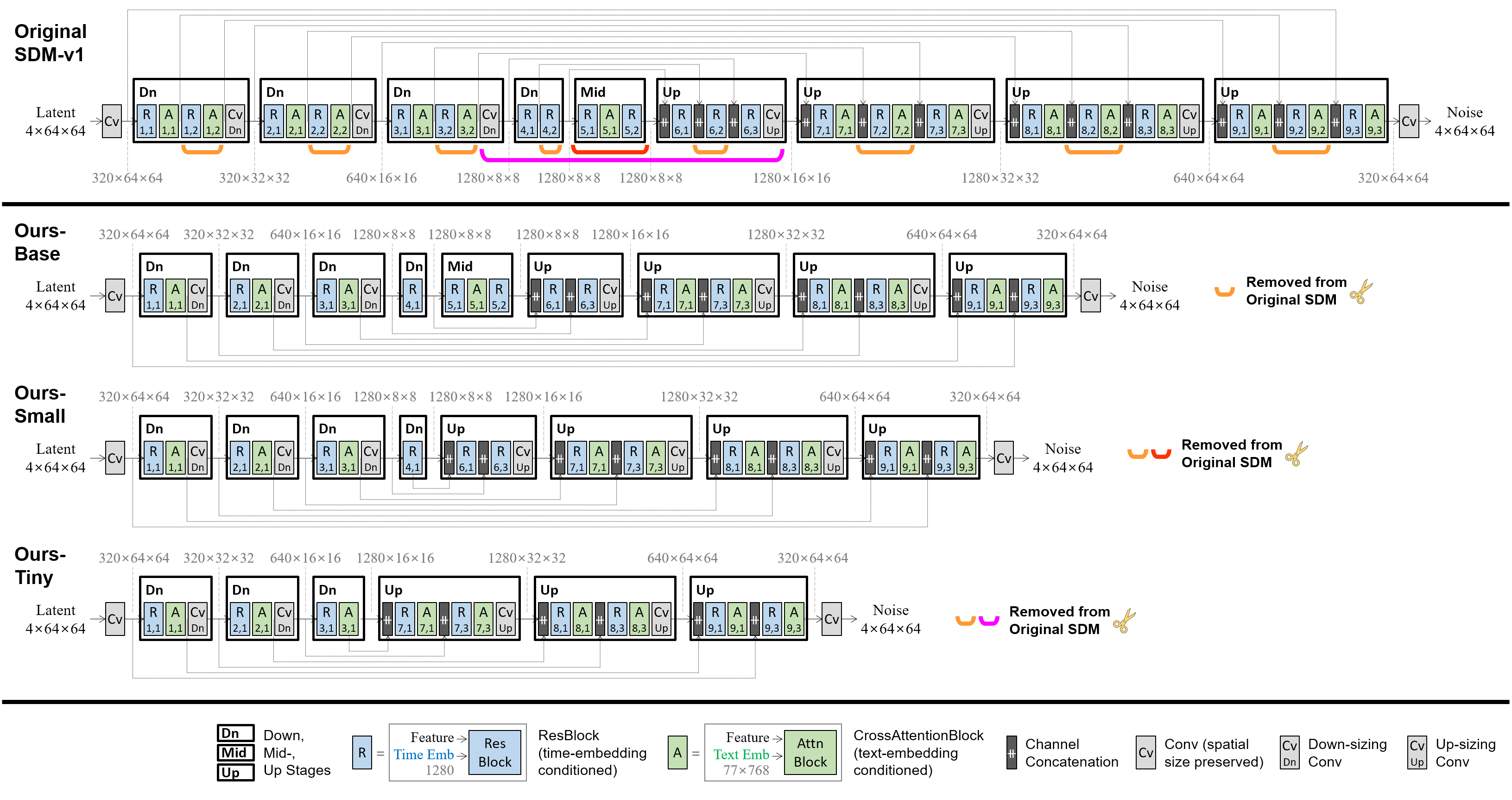Palettized Core ML Weights for BK-SDMs
For deployment on iOS 17 or macOS 14, this model card introduces palettized Core ML weights of BK-SDM-{Base-2M, Small-2M and Tiny-2M}. These weights were generated using Apple’s repository which has ASCL.
- Block-removed Knowledge-distilled Stable Diffusion Model (BK-SDM) is an architecturally compressed SDM for efficient text-to-image synthesis. This model is bulit with (i) removing several residual and attention blocks from the U-Net of Stable Diffusion v1.4 and (ii) distillation pretraining. Despite being trained with very limited resources, our compact model can imitate the original SDM by benefiting from transferred knowledge.
- More information about BK-SDMs: Paper, GitHub, Demo.
A demo to use Core ML Stable Diffusion weights can be found here.
Deployment Results
| Base Model Name | Pipeline Size | Quantization Type | Attention Implementation |
|---|---|---|---|
| BK-SDM-Base-2M (Ours) | 1.48GB | Palettized | split_einsum_v2 |
| BK-SDM-Small-2M (Ours) | 1.44GB | Palettized | split_einsum_v2 |
| BK-SDM-Tiny-2M (Ours) | 1.43GB | Palettized | split_einsum_v2 |
| OFA-Sys' Small Stable Diffusion v0 | 3.28GB | None | split_einsum |
| Apple's Stable Diffusion v1.4, Palettized | 1.57GB | Palettized | split_einsum_v2 |

Compression Method
U-Net Architecture
Certain residual and attention blocks were eliminated from the U-Net of SDM-v1.4:
- 1.04B-param SDM-v1.4 (0.86B-param U-Net): the original source model.
- 0.76B-param BK-SDM-Base (0.58B-param U-Net): obtained with ① fewer blocks in outer stages.
- 0.66B-param BK-SDM-Small (0.49B-param U-Net): obtained with ① and ② mid-stage removal.
- 0.50B-param BK-SDM-Tiny (0.33B-param U-Net): obtained with ①, ②, and ③ further inner-stage removal.

Distillation Pretraining
The compact U-Net was trained to mimic the behavior of the original U-Net. We leveraged feature-level and output-level distillation, along with the denoising task loss.

Uses
Note: This section is taken from the Stable Diffusion v1 model card) (which was based on the DALLE-MINI model card) and applies in the same way to BK-SDMs.
Direct Use
The model is intended for research purposes only. Possible research areas and tasks include
- Safe deployment of models which have the potential to generate harmful content.
- Probing and understanding the limitations and biases of generative models.
- Generation of artworks and use in design and other artistic processes.
- Applications in educational or creative tools.
- Research on generative models.
Excluded uses are described below.
Misuse, Malicious Use, and Out-of-Scope Use
The model should not be used to intentionally create or disseminate images that create hostile or alienating environments for people. This includes generating images that people would foreseeably find disturbing, distressing, or offensive; or content that propagates historical or current stereotypes.
Out-of-Scope Use
The model was not trained to be factual or true representations of people or events, and therefore using the model to generate such content is out-of-scope for the abilities of this model.
Misuse and Malicious Use
Using the model to generate content that is cruel to individuals is a misuse of this model. This includes, but is not limited to:
- Generating demeaning, dehumanizing, or otherwise harmful representations of people or their environments, cultures, religions, etc.
- Intentionally promoting or propagating discriminatory content or harmful stereotypes.
- Impersonating individuals without their consent.
- Sexual content without consent of the people who might see it.
- Mis- and disinformation
- Representations of egregious violence and gore
- Sharing of copyrighted or licensed material in violation of its terms of use.
- Sharing content that is an alteration of copyrighted or licensed material in violation of its terms of use.
Limitations and Bias
Limitations
- The model does not achieve perfect photorealism
- The model cannot render legible text
- The model does not perform well on more difficult tasks which involve compositionality, such as rendering an image corresponding to “A red cube on top of a blue sphere”
- Faces and people in general may not be generated properly.
- The model was trained mainly with English captions and will not work as well in other languages.
- The autoencoding part of the model is lossy
- The model was trained on a large-scale dataset LAION-5B which contains adult material and is not fit for product use without additional safety mechanisms and considerations.
- No additional measures were used to deduplicate the dataset. As a result, we observe some degree of memorization for images that are duplicated in the training data. The training data can be searched at https://rom1504.github.io/clip-retrieval/ to possibly assist in the detection of memorized images.
Bias
While the capabilities of image generation models are impressive, they can also reinforce or exacerbate social biases. Stable Diffusion v1 was trained on subsets of LAION-2B(en), which consists of images that are primarily limited to English descriptions. Texts and images from communities and cultures that use other languages are likely to be insufficiently accounted for. This affects the overall output of the model, as white and western cultures are often set as the default. Further, the ability of the model to generate content with non-English prompts is significantly worse than with English-language prompts.
Safety Module
The intended use of this model is with the Safety Checker in Diffusers. This checker works by checking model outputs against known hard-coded NSFW concepts. The concepts are intentionally hidden to reduce the likelihood of reverse-engineering this filter. Specifically, the checker compares the class probability of harmful concepts in the embedding space of the CLIPTextModel after generation of the images. The concepts are passed into the model with the generated image and compared to a hand-engineered weight for each NSFW concept.
Acknowledgments
- We express our gratitude to Microsoft for Startups Founders Hub for generously providing the Azure credits used during pretraining.
- We deeply appreciate the pioneering research on Latent/Stable Diffusion conducted by CompVis, Runway, and Stability AI.
- We also appreciate the effort from Apple for the Core ML Stable Diffusion library.
- Special thanks to the contributors to LAION, Diffusers, and Gradio for their valuable support.
Citation
@article{kim2023architectural,
title={BK-SDM: A Lightweight, Fast, and Cheap Version of Stable Diffusion},
author={Kim, Bo-Kyeong and Song, Hyoung-Kyu and Castells, Thibault and Choi, Shinkook},
journal={arXiv preprint arXiv:2305.15798},
year={2023},
url={https://arxiv.org/abs/2305.15798}
}
@article{kim2023bksdm,
title={BK-SDM: Architecturally Compressed Stable Diffusion for Efficient Text-to-Image Generation},
author={Kim, Bo-Kyeong and Song, Hyoung-Kyu and Castells, Thibault and Choi, Shinkook},
journal={ICML Workshop on Efficient Systems for Foundation Models (ES-FoMo)},
year={2023},
url={https://openreview.net/forum?id=bOVydU0XKC}
}
This model card was written by Thibault Castells and is based on the bk-sdm-base model card and the coreml-stable-diffusion-1-4-palettized model card.